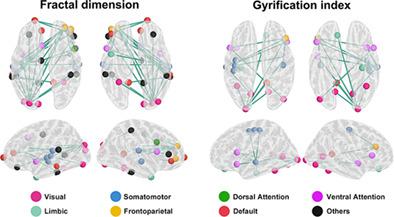当前位置:
X-MOL 学术
›
Hum. Brain Mapp.
›
论文详情
Our official English website, www.x-mol.net, welcomes your feedback! (Note: you will need to create a separate account there.)
Multiparametric and multilevel characterization of morphological alterations in patients with transient ischemic attack
Human Brain Mapping ( IF 4.8 ) Pub Date : 2021-01-19 , DOI: 10.1002/hbm.25344 Yating Lv 1, 2, 3, 4 , Wei Wei 1, 2, 3, 4 , Xiujie Han 4 , Yulin Song 4 , Yu Han 5 , Chengshu Zhou 4 , Dan Zhou 4 , Fuding Zhang 4 , Xiaoyan Wu 6 , Jinling Liu 7 , Lijuan Zhao 4 , Cairong Zhang 4 , Ningkai Wang 8, 9 , Jinhui Wang 8, 9
Human Brain Mapping ( IF 4.8 ) Pub Date : 2021-01-19 , DOI: 10.1002/hbm.25344 Yating Lv 1, 2, 3, 4 , Wei Wei 1, 2, 3, 4 , Xiujie Han 4 , Yulin Song 4 , Yu Han 5 , Chengshu Zhou 4 , Dan Zhou 4 , Fuding Zhang 4 , Xiaoyan Wu 6 , Jinling Liu 7 , Lijuan Zhao 4 , Cairong Zhang 4 , Ningkai Wang 8, 9 , Jinhui Wang 8, 9
Affiliation

|
Transient ischemic attack (TIA), an important risk factor for stroke, is associated with widespread disruptions of functional brain architecture. However, TIA‐related structural alterations are not well established. By analyzing structural MRI data from 50 TIA patients versus 40 healthy controls (HCs), here we systematically investigated TIA‐related morphological alterations in multiple cortical surface‐based indices (cortical thickness [CT], fractal dimension [FD], gyrification index [GI], and sulcal depth [SD]) at multiple levels (local topography, interregional connectivity and whole‐brain network topology). For the observed alterations, their associations with clinical risk factors and abilities as diagnostic and prognostic biomarkers were further examined. We found that compared with the HCs, the TIA patients showed widespread morphological alterations and the alterations depended on choices of morphological index and analytical level. Specifically, the patients exhibited: (a) regional CT decreases in the transverse temporal gyrus and lateral sulcus; (b) impaired FD‐ and GI‐based connectivity mainly involving visual, somatomotor and ventral attention networks and interhemispheric connections; and (c) altered GI‐based whole‐brain network efficiency and decreased FD‐based nodal centrality in the middle frontal gyrus. Moreover, the impaired morphological connectivity showed high sensitivities and specificities for distinguishing the patients from HCs. Altogether, these findings demonstrate the emergence of morphological index‐dependent and analytical level‐specific alterations in TIA, which provide novel insights into neurobiological mechanisms underlying TIA and may serve as potential biomarkers to help diagnosis of the disease. Meanwhile, our findings highlight the necessity of using multiparametric and multilevel approaches for a complete mapping of cerebral morphology in health and disease.
中文翻译:

短暂性脑缺血发作患者形态学改变的多参数和多水平表征
短暂性脑缺血发作 (TIA) 是中风的一个重要危险因素,与功能性大脑结构的广泛破坏有关。然而,与 TIA 相关的结构改变尚未完全确定。通过分析 50 名 TIA 患者与 40 名健康对照 (HC) 的结构 MRI 数据,我们在此系统地研究了多个基于皮质表面的指标(皮质厚度 [CT]、分形维数 [FD]、回旋指数 [GI] 中与 TIA 相关的形态学变化。 ]和脑沟深度[SD])在多个层次(局部地形、区域间连通性和全脑网络拓扑)。对于观察到的变化,进一步检查了它们与临床风险因素以及作为诊断和预后生物标志物的能力的关联。我们发现,与 HC 相比,TIA患者表现出广泛的形态学改变,改变取决于形态学指标和分析水平的选择。具体来说,患者表现出:(a)颞横回和外侧沟的区域 CT 降低;(b) 基于 FD 和 GI 的连接受损,主要涉及视觉、躯体运动和腹侧注意网络以及大脑半球间连接;(c) 改变了基于 GI 的全脑网络效率,降低了额中回基于 FD 的节点中心性。此外,受损的形态连接显示出区分患者与 HC 的高敏感性和特异性。总之,这些发现表明 TIA 中出现了形态学指数依赖性和分析水平特异性改变,这为 TIA 的神经生物学机制提供了新的见解,并可能作为潜在的生物标志物来帮助诊断该疾病。同时,我们的研究结果强调了使用多参数和多层次方法来完整绘制健康和疾病中的大脑形态的必要性。
更新日期:2021-01-19
中文翻译:

短暂性脑缺血发作患者形态学改变的多参数和多水平表征
短暂性脑缺血发作 (TIA) 是中风的一个重要危险因素,与功能性大脑结构的广泛破坏有关。然而,与 TIA 相关的结构改变尚未完全确定。通过分析 50 名 TIA 患者与 40 名健康对照 (HC) 的结构 MRI 数据,我们在此系统地研究了多个基于皮质表面的指标(皮质厚度 [CT]、分形维数 [FD]、回旋指数 [GI] 中与 TIA 相关的形态学变化。 ]和脑沟深度[SD])在多个层次(局部地形、区域间连通性和全脑网络拓扑)。对于观察到的变化,进一步检查了它们与临床风险因素以及作为诊断和预后生物标志物的能力的关联。我们发现,与 HC 相比,TIA患者表现出广泛的形态学改变,改变取决于形态学指标和分析水平的选择。具体来说,患者表现出:(a)颞横回和外侧沟的区域 CT 降低;(b) 基于 FD 和 GI 的连接受损,主要涉及视觉、躯体运动和腹侧注意网络以及大脑半球间连接;(c) 改变了基于 GI 的全脑网络效率,降低了额中回基于 FD 的节点中心性。此外,受损的形态连接显示出区分患者与 HC 的高敏感性和特异性。总之,这些发现表明 TIA 中出现了形态学指数依赖性和分析水平特异性改变,这为 TIA 的神经生物学机制提供了新的见解,并可能作为潜在的生物标志物来帮助诊断该疾病。同时,我们的研究结果强调了使用多参数和多层次方法来完整绘制健康和疾病中的大脑形态的必要性。

























 京公网安备 11010802027423号
京公网安备 11010802027423号